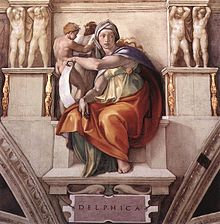Sibyl of Delphi

The Delphic Sibyl is one of those named after Varro , a Roman historian of the 1st century BC. BC , ten sibyls differentiated from lactance , each provided with a geographical epithet .
The Delphic Sibyl was a legendary prophetess who is said to have prophesied in Delphi . However, she did not belong to the oracle of Delphi and should not be equated with Pythia , the priestess of Apollo . So is z. For example, in the oracle district of Delphi outside the actual sanctuary, a separate “ Sibylle Rock” can be found, on which, according to Pausanias, the Sibylle is said to have raised her voice.
Based on lactance , the Christian Middle Ages and the Renaissance understood the Delphic Sibyl as a pagan herald of an expectation of God, almost on a par with the prophets .
In Gothic and Renaissance art , the Delphic Sibyl is usually depicted as one in a series of sibyls based on Varro, often in contrast to an often equal number of prophets from the Old Testament.
The best known pictorial representation is the Delphica of Michelangelo in the fresco on the ceiling of the Sistine Chapel , where five Sibyls are a total alternating with seven prophets. She is shown as the youngest of the Sibyls, in contrast to the Sibyl from Persia in particular .
Further representations of a Delphic Sibyl are u. a. found in the following locations:
- Ulm , Gothic half-sculpture in the choir stalls of the cathedral, as one of ten sibyls, in the total work of art with numerous ancient scholars and prophets
- Rome , Church of Santa Maria del Popolo , as one of the four Sibyls of Pinturicchio .